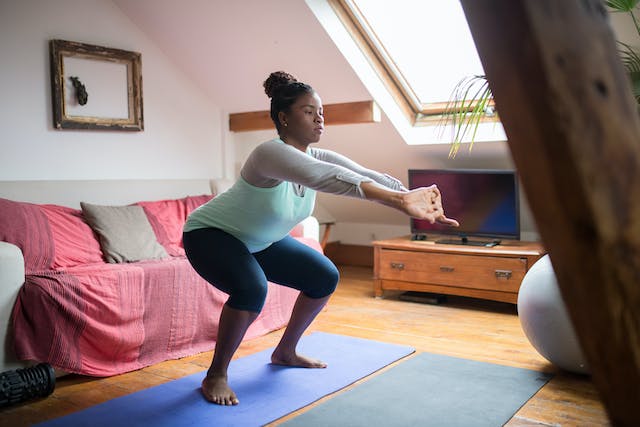In today’s fast-paced world, finding time to hit the gym can be a challenge for many individuals. Whether it’s due to a hectic schedule, budget constraints, or simply a preference for privacy, more and more people are opting for home workouts. The good news is that you don’t need a gym membership or fancy equipment to stay fit and healthy. In this article, we’ll explore effective workout routines that you can do in the comfort of your own home as recommended by physiotherapists and personal trainers.
1. Bodyweight Exercises: The Foundation Of Home Fitness
Bodyweight exercises are the cornerstone of home workouts, requiring nothing more than your own body and some dedication. These exercises target various muscle groups and provide a full-body workout. Squats, lunges, push-ups, and planks are excellent examples of bodyweight exercises that engage multiple muscle groups and can be modified to suit your fitness level.
- Squats: Stand with your feet shoulder-width apart and lower your hips back and down as if you’re sitting into an imaginary chair. Keep your chest up, and push through your heels to return to the starting position.
- Push-ups: Start in a plank position with your hands placed slightly wider than shoulder-width apart. Lower your body towards the ground by bending your elbows and then push back up.
- Planks: Get into a push-up position and hold your body in a straight line from head to heels. Engage your core muscles and hold the position for as long as you can.
2. Cardiovascular Workouts: Get Your Heart Pumping
Cardiovascular exercises are crucial for heart health and can be easily incorporated into your home fitness routine. Jumping jacks, high knees, and mountain climbers are simple yet effective cardio exercises that require minimal space.
- Jumping Jacks: Stand with your feet together and arms at your sides. Jump your feet out while raising your arms overhead, then quickly return to the starting position.
- High Knees: Stand in place and lift your knees as high as possible, alternating legs in a running motion. Pump your arms to increase the intensity.
- Mountain Climbers: Get into a plank position and bring one knee towards your chest, then quickly switch legs in a running motion.
3. Resistance Training: Make Use Of Household Items
You don’t need a set of dumbbells to incorporate resistance training into your home workout. Everyday household items like water bottles, backpacks, or even cans of food can be used as improvised weights.
- Water Bottle Bicep Curls: Fill two water bottles with an appropriate amount of water and hold one in each hand. Perform bicep curls by bending your elbows and bringing the bottles towards your shoulders.
- Backpack Squats: Load a backpack with books or other heavy items. Wear the backpack and perform squats as you would without the added weight.
4. Yoga And Pilates: Build Strength And Flexibility
Yoga and Pilates are excellent options for home workouts that focus on building strength, flexibility, and balance. Follow online videos or apps that guide you through different poses and movements.
- Yoga Poses: Incorporate poses like downward dog, warrior poses, and sun salutations to improve flexibility and balance.
- Pilates Movements: Pilates exercises often target the core muscles. Include moves like the plank, leg lifts, and Pilates push-ups for a comprehensive workout.
5. Online Workout Resources: Bring The Gym To Your Living Room
The internet is a treasure trove of workout resources that cater to all fitness levels and preferences. Many fitness influencers and certified trainers offer free or subscription-based online workout programs. From high-intensity interval training (HIIT) sessions to dance workouts, you can find a variety of options to keep your home workouts exciting and effective.
AVOID THESE PITFALLS
While home workouts offer convenience and flexibility, it’s essential to be mindful of certain pitfalls to ensure a safe and effective fitness routine. Here are some things to avoid when doing home workouts:
Lack of Warm-Up and Cool Down
- Avoid: Skipping warm-up and cool-down exercises.
- Why: Warming up prepares your body for physical activity by increasing blood flow and flexibility. Skipping this step may lead to injuries. Similarly, a proper cool down helps reduce muscle soreness and promotes flexibility.
Poor Form
- Avoid: Sacrificing form for quantity or speed.
- Why: Incorrect form can lead to injuries and decrease the effectiveness of the workout. Focus on proper technique, even if it means performing fewer repetitions.
Overtraining
- Avoid: Excessive workouts without adequate rest.
- Why: Overtraining can lead to fatigue, increased risk of injury, and burnout. Allow your body time to recover between sessions and incorporate rest days into your routine.
Ignoring Pain, Fatigue, Stress or Illness
- Avoid: Pushing through sharp or persistent pain or ignoring signs of fatigue, stress, or illness.
- Why: Pain is your body’s way of signaling that something is wrong. Ignoring pain can lead to serious injuries. If you experience discomfort beyond typical muscle fatigue, modify the exercise or consult a physiotherapist.
Inconsistency
- Avoid: Irregular or sporadic workout habits.
- Why: Consistency is crucial for seeing results. Aim for a regular workout schedule that suits your lifestyle, whether it’s daily, a few times a week, or whatever works best for you.
Neglecting Variety
- Avoid: Sticking to the same routine without variation.
- Why: Doing the same exercises repeatedly may lead to plateaus and boredom. Keep your workouts interesting by incorporating different exercises and
Neglecting Hydration and Nutrition
- Avoid: Working out on an empty stomach or neglecting hydration.
- Why: Proper nutrition and hydration are vital for energy and recovery. Fuel your body with balanced meals and stay hydrated to optimize your workout performance and overall health.
In conclusion, staying fit at home is not only achievable but can also be enjoyable. With a combination of bodyweight exercises, cardiovascular workouts, resistance training, yoga, and online resources, you can create a well-rounded fitness routine without the need for a gym membership. The key is to stay consistent, listen to your body, and make adjustments as needed. Embrace the flexibility and convenience of home workouts, and you’ll be on your way to a healthier, stronger you.



